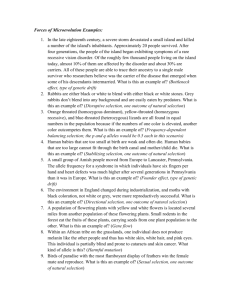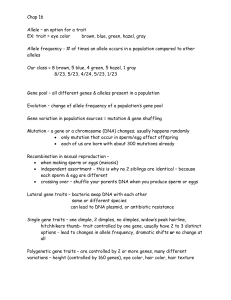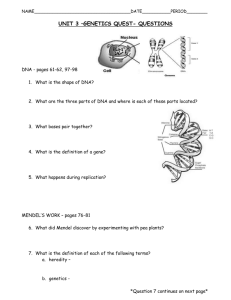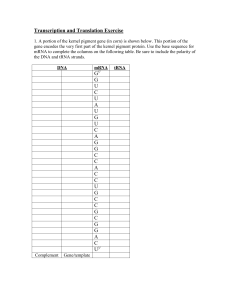Biology 163 Laboratory in Genetics, Final Exam,
advertisement
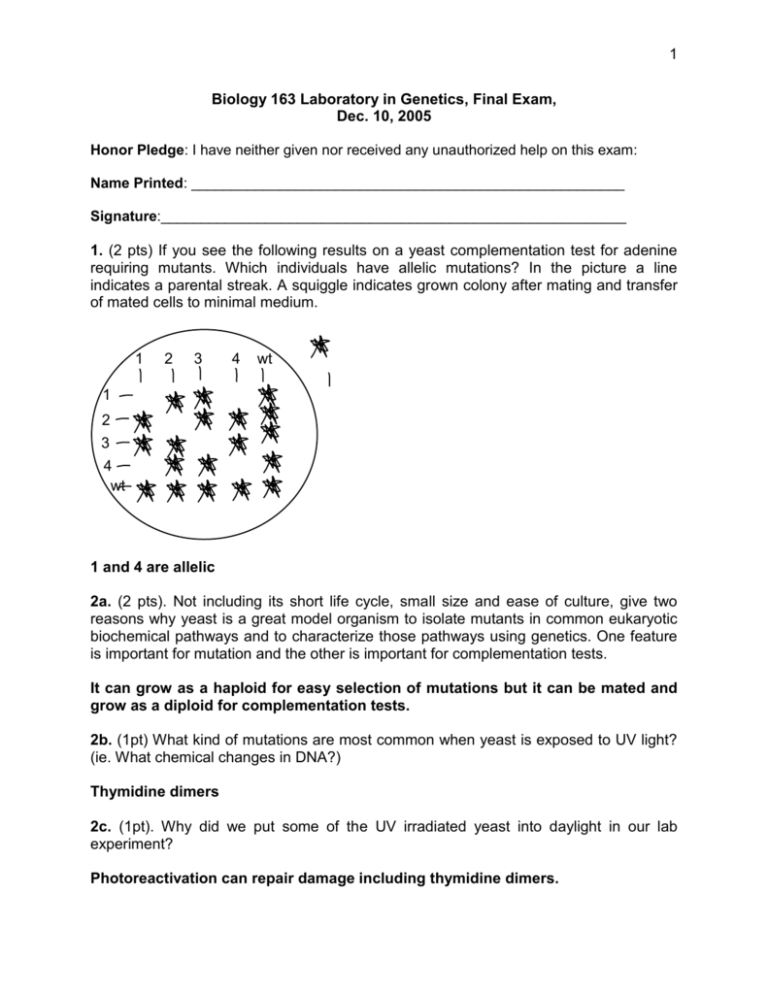
1 Biology 163 Laboratory in Genetics, Final Exam, Dec. 10, 2005 Honor Pledge: I have neither given nor received any unauthorized help on this exam: Name Printed: ______________________________________________________ Signature:__________________________________________________________ 1. (2 pts) If you see the following results on a yeast complementation test for adenine requiring mutants. Which individuals have allelic mutations? In the picture a line indicates a parental streak. A squiggle indicates grown colony after mating and transfer of mated cells to minimal medium. 1 2 3 4 wt 1 2 3 4 wt 1 and 4 are allelic 2a. (2 pts). Not including its short life cycle, small size and ease of culture, give two reasons why yeast is a great model organism to isolate mutants in common eukaryotic biochemical pathways and to characterize those pathways using genetics. One feature is important for mutation and the other is important for complementation tests. It can grow as a haploid for easy selection of mutations but it can be mated and grow as a diploid for complementation tests. 2b. (1pt) What kind of mutations are most common when yeast is exposed to UV light? (ie. What chemical changes in DNA?) Thymidine dimers 2c. (1pt). Why did we put some of the UV irradiated yeast into daylight in our lab experiment? Photoreactivation can repair damage including thymidine dimers. 2 9. (replaced 3 from 2005 in 2006) In particular type of wild flower, the wild type flower is deep purple and the plants are true breeding. In one true-breeding mutant stock, the flowers have a reduced pigmentation, resulting in a lavender color. In a different true breeding mutant stock, the flowers have no pigmentation and are white. A lavender flowered plant from the first mutant stock was crossed to a white flowered plant from the second mutant stock. The 100 F1 plants all had deep purple flowers. The F1 plants were allowed to self-fertilize to produce an F2 generation. The 277 F2 plants were 157 purple: 71 white: 49 lavender. When lavender F2 plants were allowed to self fertilize, both lavender and white-flowered plants were produced. Is the white mutation an allele of the same gene as the lavender mutation? Explain your answer (2 pts). You have complementation in the F1 to wild type. This would not happen if the plant only had a white allele and a lavender allele at the same locus. Why are there only three classes of phenotypes in the F2? (1 pt). The recessive white allele at one locus is epistatic to the lavender allele at the other locus. Why do the lavender plants in the F2 have some white progeny? (1pt). Lavender plants have at least one wild type copy of White but they could have a recessive allele as well. If they have a recessive allele of white they can have homozygous progeny when they are self fertilized. These will be white. Would the white plants have purple or lavender progeny if self fertilized? (1pt). They would only have white flowers because all white flowered plants are homozygous for the epistatic white allele. 4. You start with a maize plant that is heterozygous at three loci: Lz (Lazy: the homozygous recessive mutant grows along the ground like a vine) Gl (Glossy leaf: the homozygous mutant has a defect in surface wax and is unusually shiny) and Su (sugary endosperm: the recessive mutants do not make starch properly and the kernels collapse when they dry down). In order to estimate the linkage relationships of the three genes you perform a test cross to a homozygous recessive mutant. You get the following number of progeny: Normal (wild type) 286 3 Lazy 33 Glossy 59 Sugary 4 Lazy and glossy 2 Lazy and sugary 44 Glossy and sugary 40 Lazy, glossy and sugary 272 4a. (1 pt) How do you know that the genes are all linked? The parental types are the majority 4b. (1 pt) Which of the three genes is in the middle between the other two? Sugary 4c. (6 pts) Calculate the recombination distances between each gene (in cM) and the total distance represented by all three genes. Lz-su = 40+33+4+2/740 X 100 cM = 10.7 cM Su-Gl = 59+44+4+2/740 X 100 cM = 14.7 cM Lz-Gl = 25.4 cM 5. (1 pt) What is one major advantage of PCR based markers over methods such as Southern Blot techniques for forensic studies? You can use very small amounts of DNA The PCR technique is accomplished more quickly You don’t need radioactivity for the PCR technique 6a. (1 pt) If you inject a C. elegans in the gut with a dsRNA homologous to the C. elgans gene for pos1 (a gene essential for embryo development) why does that block the expression of POS1 protein in the embryos, which are in a completely different part of the C. elegans from the point of injection? RNAi effect can spread 4 6b. (1 pt) If you injected only 100 dsRNA molecules homologous to pos1 into the gut of a hermaphrodite worm and it laid 1000 eggs, none of them would be viable. How can 100 molecules of dsRNA block production of protein from of hundreds of pos1 mRNA molecules in each embryo? Amplification of small RNAs 5 7. You did an interrupted mating and you found the following results: 7a. What was the gene order with respect to the origin of transfer of the integrated F plasmid? (1 pt) azi ton lac gal 7b. How does an F plasmid become integrated into the chromosome to make an Hfr strain? (1 pt) Homologous recombination with insertion elements 8. You are working in a forensics lab on a paternity case. You have done PCR reactions to test each individual involved, mother child and two potential fathers. The resulting gels are illustrated below. You have tested 4 diagnostic loci A B C and D. 6 Mother A B C D Child A B C D Man 1 A B C D Man 2 A B C D 8a. (1pt) Which man do you suggest should be paying child support? Man 1 8b. (1 pt) Which loci are informative for your decision Locus B 9. DNA markers are often designed around sites of short (2-4 base pair) repeats or microsatellites or sites of slightly longer repeated sequences (10-100 bp) called minisatellites because they are highly polymorphic. 9a. (2pts) Explain the DNA synthesis problem that is responsible for microsatellites being polymorphic. DNA polymerase pauses on the template. It may disassociate and reanneal in the wrong place leading to an incorrect number of repeats being copied. Polymerase slippage is acceptable as an answer. 9b. (2 pts) Explain why minisatellites are more highly polymorphic than single site mutations. Mispairing of the repeats in meiosis 7 10a. (1 pt) Why are Y chromosome markers easier to use for studying human evolution than markers from autosomes. Give one reason. They do not recombine with another chromosome in meiosis. 10b. (1 pt) What kind of DNA markers are useful for following a family tree from mother to daughter? Mitochondrial DNA 11. You are using DNA markers to map a gene in Arabidopsis. You are using the method of interval mapping that we used in our lab exercise. The gene you are trying to locate is a recessive allele of a gene for late flowering lf1. You have crossed the mutant in a Col-0 genetic background to a wild type plant of the La-er genetic background. You have chosen 20 F2 plants to use for mapping. They are all homozygous for the lf1 mutant allele from the Col-0 parent. After scoring the results from 5 markers you have the following data. The two alleles of each plant are scored as C/C for Col-0 homozygotes, C/L for heterozygotes or L/L for La-er homozygotes 1 2 3 4 5 6 7 8 9 10 11 12 13 14 15 16 17 18 19 20 Marker 1 C/C C/L C/L C/L C/C C/L C/C C/C C/C C/L C/C C/C C/L C/L C/C C/L C/C C/C C/L C/C Marker 2 L/L C/L C/C C/C C/L L/L C/C C/L L/L C/L C/C C/L L/L C/L C/L C/C C/L L/L L/L C/L Marker 3 C/C C/C C/C C/C C/C C/C C/L C/C C/C C/L C/C C/C C/C C/L C/C C/C C/C C/C C/C C/C Marker 4 L/L C/C C/C C/L C/C C/C C/C C/L C/C C/C C/C C/C C/C C/C L/L C/C C/L C/L C/C C/L 11a. (1 pt) Which marker is closest to the lf1 gene? 3 Marker 5 C/C C/L C/L C/L C/L L/L C/L C/C C/L C/L C/L C/L C/L C/L C/L L/L C/L C/C L/L C/L 8 11b. (1 pt) What is the next closest marker on the other side of the lf1 gene (2 pts) 4 11c. (2 pts) Assume you have access to 200 more F2 plants. What is the next step towards map based cloning of the lf1 gene? Pick all the lf1/lf1 homozygotes and test them for heterozygosity at one of either 5 or 3. These plants will have a recombination within the 5-3 interval and be useful for mapping with more markers. 12. You are cloning a gene and you sequence a candidate predicted gene. If you see a point mutation in your mutant, you still cannot be sure that you have found the gene of interest. 12a. (1pt) Why would a point mutation not necessarily mean you have found the affected gene? A point mutation may not alter function of protein. First it may not change the amino acid sequence. Even if it does change the amino acid sequence, some substitutions still leave the protein functional. 12b. (1 pt) If the mutation lead to a stop codon or frame shift why would this be a better sign that you had the gene. More likely to be loss of function. 12c. (2 pts) What two other steps would you still need to do to prove this was the gene of interest? Sequence other mutant alleles with same phenotype Transform mutant to complement mutation 13. You want to clone a gene for human growth hormone into a bacterial plasmid so that the protein can be produced from bacteria. You have the following cloning vector: 9 The MCS or multiple cloning site starts with the enzyme KpnI closest to the lac promoter and ends with SacI. The order of enzyme sites in the MCS is illustrated below. All of the restriction sites are only present once in the pBluescript plasmid. All of them give sticky ends when cut. None of them give sticky ends that can reanneal with the sticky ends of the other sites. It is cut leaving blunt ends. MCS: KpnI BamHI HindIII Acc1 SalI XhoI SacI Lac Promoter /-----------------------70 bp-------------------/ Lac coding seq. The human growth hormone transcript is cloned in the following piece of DNA from a cDNA library. The restriction sites shown only cut within the insert at the sites indicated. They do not cut elsewhere in the cDNA clone. The plasmid vector is not shown. Assume the relative distances between restriction sites are drawn to scale for the diagram below. SacI EcoRV BamHI SalI EcoRV XhoI SalI KpnI ATG-------------------------------------------------------stop /--------------------------------------------3kb----------------------------------------------/ 13a. (2pts) Choose the restriction sites to most efficiently clone the human growth hormone cDNA into the pBluescript vector in the correct orientation so the human growth hormone will be expressed from the lac promoter. Cut both vector and cloned fragment with BamHI and XhoI and ligate 10 14. (5 pts) Choose the model organism most appropriate for the following studies from the list provided. a. Analysis of basic biochemical processes common to all eukaryotes. b. Map based cloning of a human genetic disease c. Patterning in embryo development d. Mutant screen to find genes required for RNAi e. Identification of genes for photosynthesis 1. 2. 3. 4. 5. 6. 7. 2 7 3 5 4 E. coli Yeast Drosophila Arabidopsis C. elegans Mouse Human 15. The following pedigree is for a family in which some members have Harvey-Grant syndrome. It causes development of an extra toe on the left foot. In the pedigree, individuals with the Harvey-Grant syndrome are represented by black, filled-in symbols. You have evidence to suggest that a DNA marker is linked to the Harvey-Grant gene. Two common alleles of the DNA marker are known and you have tested each member of the family to see what alleles they have in order to confirm your suspicion that the marker is closely linked to the Harvey-Grant gene. 15a. (2 pts) What is the most likely genetic basis for the Harvey-Grant syndrome? Explain your answer. Dominant autosomal because you have a 1:1 ratio of affected to unaffected individuals and it appears in both males and females. 15b. (1 pt) Is it likely or unlikely that the Harvey-Grant locus is linked to the DNA marker? Explain your answer. Likely. All individuals in generation II that have the Harvey-Grant mutation have the 1 allele of the marker and none have the 2 allele from the father. In generation 3 the linkage is allele 2 of the DNA marker with the gene but allele 2 came from 11 the affected father. He was a heterozygote for DNA marker allele 1 and 2. He must have inherited a chromosome from his father with a recombination event between the Harvey-Grant gene and the DNA marker. In Generation 3 those individuals who must have allele 2 from the father are all affected and those with allele 1 are not affected. 15c. (1 pt) Sequence analysis shows that the DNA marker resides in the middle of a coding region. Could that coding region actually be the Harvey-Grant gene? Explain your answer. No because there has been a recombination event between the DNA marker and the Harvey-Grant gene.




